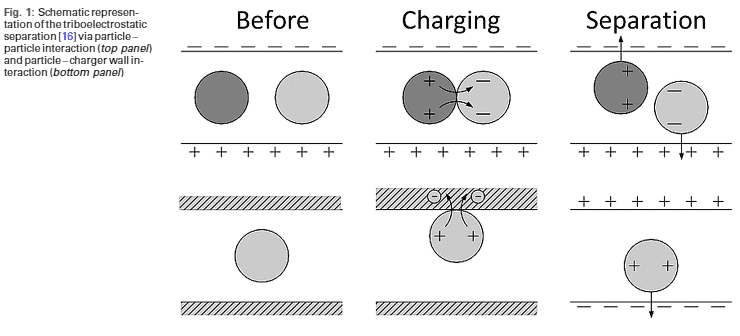Vyberte jazyk:
Monika Mirkowska, Markus Kratzer, Kresťanské Teichert, and Helmut Flachberger
Abstraktné
Triboelectrostatic separation is a promising method used to separate non-conductive minerals. Avšak, the knowledge about the underlying triboelectrification mechanisms is still very limited. Tak, predicting the separation results and finding proper separation parameters are challenging tasks. This article presents a comprehensive summary of phenomena and factors which play a decisive role in the charging behavior of non-conductors and, by implication, the efficiency of the separation process, such as water and adsorbents layers on the surface, drsnosť povrchu, humidity, type of contact, Atď. The authors hope that this article opens a way for a systematic approach through basic experiments dedicated to a better understanding of triboelectrification processes.
Kľúčové slová: Triboelectrostatic separation, Triboelectrification, Contact charging, Minerálne látky, Insulators
Hauptfaktoren der Triboaufladung von Mineralphasenfür eine erfolgreiche elektrostatische Trennung – einÜberblick
Zusammenfassung:Die Elektroscheidung nach Triboaufla-dung stellt eine vielversprechende Methode zur Trennungnicht leitfähiger Mineralphasen dar. Das begrenzte Wissenüber die zugrundeliegenden Mechanismen der Triboaufla-dung macht die Vorhersage von über einzustellende Pro-zessparameter zu erzielenden Trennergebnissen zu einerherausfordernden Aufgabe.
Diese Veröffentlichung gibt einen umfassenden Über-blick über Phänomene und Faktoren, die eine entscheiden-de Rolle beim Aufladeverhalten von Nichtleitern spielenoder spielen können und die damit Einfluss auf die Ef-fizienz der Trennung nehmen. Solche Faktoren könnensein: Wasser- und Adsorbatschichten, Oberflächenrauig-keit, Luftfeuchtigkeit, Kontaktart, usw. Die Autoren hoffen,dass dieser Artikel Wege für einen systematischen Ansatzdurch grundlegende Experimente aufzeigt und damit zueinem besseren Verständnis der bei der Triboaufladungwirkenden Faktoren beiträgt.
Schlüsselwörter:Elektroscheidung, Triboaufladung,Mineralien, Isolatoren
Úvod
Triboelectrostatic separation is an inexpensive environ-mentally friendly separation technique, which has the potential to take over a greater significance of mineral processing and polymer recycling. It has been successfully applied for the separation of salts, calcite quartz, feldspar quartz, carbon as coal, and even for the purification of secondary materials like plastic. Všeobecne platí, že, it is based on triboelectrification, which is the generation of net charges on insulating powder materials by bringing powder grains into contact with each other and the device walls. The grains, differently charged upon contact, are separated in a strong electric field depending on the sign and amount of the charge they carry. Avšak, an application as a widespread separation method is limited due to the complexity of the involved interactions, which make it technologically difficult to adjust the proper process parameters. Different factors like the behavior of the powder stream, the environmental conditions (humidity, teplota, Atď), the mechanical and electrical properties of the individual grains as well as the design of the equipment have to be considered simultaneously. Especiallytriboelectrification/contact charging is a highly non-trivial phenomenon. So far no universal model for a quantitative or even qualitative description is available. Preto, amain focus of this work is set on contact charging phenomena. We start with a brief description of the state of the art Triboelectrostatic separation technologies in Sect. 2. The discussion is continued with reviewing factors, which determine the charging behavior of insulators in Sect. 3. There the focus is set on triboelectric charging models, charge transfer mechanisms, influences like a type of contact and environment. In Sect. 4 we provide a short overview of experimental approaches for the investigations of electrification of minerals both at the macro- and micro scale. The authors hope that the article presents the complexity of the topic and will intensify systematic interdisciplinary investigations to a better understanding of triboelectrification processes. The considerations to follow are an integral part of the first author’s Ph.D. thesis, which is in the final stage.
